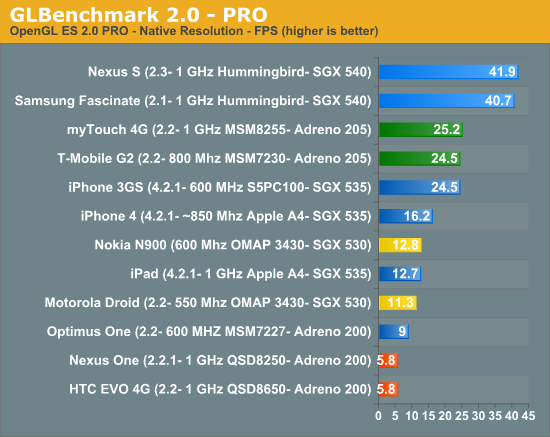GLBenchmark 2.0 Released - Modern SoCs Benchmarked
by Brian Klug on December 17, 2010 2:08 AM EST- Posted in
- Smartphones
- GLBenchmark
- Mobile
- SoCs
We're constantly on the lookout for new benchmarks to use for benchmarking the latest SoCs in devices. Today, Kishonti Informatics released GLBenchmark 2.0, the latest version of its popular GLBenchmark suite for measuring 3D graphics performance across a host of platforms: iOS, Android, Symbian, Windows Mobile, and Maemo. We've been testing it out for a while now and have some numbers of our own and from the community results. The end result is yet another look at how 3D performance stacks up between nearly all modern SoCs.
GLBenchmark 2.0 - as its name implies - tests OpenGL ES 2.0 performance on compatible devices. The suite includes two long benchmarking scenarios with a demanding combination of OpenGL ES 2.0 effects, and individual tests such as swap buffer speed (for determining the framerate cap), texture fill, triangle, and geometric tests. GLBenchmark 2.0 also leverages texture based and direct lighting, bump, environment, and radiance mapping, soft shadows, vertex shader based skinning, level of detail support, multi-pass deferred rendering, noise textures, and ETC1 texture compression.
We've been testing devices for a little while now and have a decent enough spread to make for some interesting comparison. The only extra consideration is that all of these were run at the device's respective native resolution. There's no way to change resolution, and likewise numbers cannot be scaled linearly because we may be memory bandwidth limited on some devices. GLBenchmark will join our benchmark suite for devices going forward.
First are the resolutions (native) of the devices themselves:
| Device Resolutions - GLBenchmark Native Resolution | |||||
| Google Nexus One | 800x480 WVGA | ||||
| LG Optimus One | 320x480 HVGA | ||||
| T-Mobile myTouch 4G | 800x480 WVGA | ||||
| Samsung Fascinate | 800x480 WVGA | ||||
| Google Nexus S | 800x480 WVGA | ||||
| HTC EVO 4G | 800x480 WVGA | ||||
| Apple iPhone 4 | 960x640 DVGA | ||||
| Apple iPad | 1024x768 XGA | ||||
| Motorola Droid | 854x480 FWVGA | ||||
| T-Mobile G2 | 800x480 WVGA | ||||
| Nokia N900 | 800x480 WVGA | ||||
| Apple iPhone 3GS | 320x480 HVGA | ||||
Thankfully, comparison across devices running Android is easy thanks to the relatively standard WVGA resolution guidelines for high end devices.


The first benchmark, Egypt, tests OpenGL ES 2.0 and represents the newest and most demanding benchmark. The second - GLBenchmark PRO - represents a suite that tests OpenGL ES 1.1 performance. (edit: GLBenchmark Pro also tests OpenGL ES 2.0 features, and is a port of an earlier GLBenchmark 1.1 test which focused on OpenGL ES 1.1 performance). Moving forward we will report these whenever possible on smartphone reviews.
It's pretty apparent right now that PowerVR SGX 540 still holds the lead, though the new 45 nm Qualcomms with Adreno 205 are a huge jump forwards from Adreno 200 performance wise. It's interesting that it looks like we're GPU or memory bandwidth bound on those new Qualcomms, as evidenced by the similar results the myTouch 4G and G2 post despite a 200 MHz CPU clock disparity.
Overall, GLBenchmark is designed to showcase some of the OpenGL ES 2.0 features that developers may potentially use in future gaming titles. There are a lot more low level tests which we'll be playing around with in the future and using to test in much more detail.

















64 Comments
View All Comments
ThePooBurner - Friday, December 17, 2010 - link
The N900 is known to perform substantially better at almost everything when overclocked, and most of them can run at 900mhz without breaking a sweat. Could you try running it on an OC'ed N900? :)michael2k - Friday, December 17, 2010 - link
Same HW, faster clock, but lower score? Even the iPhone 3GS scores higher... I'm assuming this is due to the screen resolution, then, more than anything else?Also, the caption for the second graph is wrong if you meant to say OpenGL ES 1.1
ltcommanderdata - Friday, December 17, 2010 - link
People have already talked about iPhone 4/iPad performance against the iPhone 3GS not looking good due to the Retina Display, but I wonder why the gap closes in the OpenGL ES 1.1 results? Perhaps the iPhone 3GS is bandwidth or CPU bound in the simpler OpenGL ES 1.1 test vs. the iPhone 4/iPad being shader and ROP bound in the OpenGL ES 2.0 test? It's interesting that the iPhone 4/iPad seem to overtake a few Android phones in the OpenGL ES 1.1 test which probably indicates different levels of OpenGL ES stack and driver optimizations.Personally, I think it would be useful to supplement the raw results with comparisons normalized to the device resolution. This will give an indication of raw GPU power and level of OpenGL ES stack and driver optimization between devices. This is especially useful to compare progress between Android devices running different OS versions.
As well, for the iPhone 4, these results give credence to the suggestion that in some cases it might be beneficial to stick with the 480x320 resolution but implement AA rather than go 960x480. The iPhone 4's 64-bit memory controller with double the memory bandwidth should be very helpful in making AA viable and sticking with a common 480x320 resolution should allow a common code path between 3rd gen and 4th gen devices which is also tempting for developers.
ltcommanderdata - Friday, December 17, 2010 - link
Oh, I don't suppose the OpenGL ES 1.1 test can be run on the previous MBX Lite based devices? It would give an interesting point of comparison of how much progress has been made in the last 2 years.madmongoose - Friday, December 17, 2010 - link
How is it a fair comparison if u compare each with its own native resolutionShouldn't they be tested at one low resolution that hopefully all support ?
DeathReborn - Friday, December 17, 2010 - link
This site lists loads of scores across various devices.http://www.glbenchmark.com/result.jsp?orderby=407&...
The Malata Zpad is the Tegra 2 device listed on there, hopefully some Advent Vega's (also Tegra 2) will be on it soon.
sarge78 - Saturday, December 18, 2010 - link
Looks like a pure GPU benchmark to me, I get the same results from going from 800Mhz all the way to 1.3Ghz (OMAP 36xx/SGX530)DesktopMan - Saturday, December 18, 2010 - link
Would have liked to see HTC Desire in these charts as it's very popular, at least here in Europe. Also, the correct name for Samsung Fascinate is Samsung I9000 Galaxy S as Fascinate is just a re-branded version for Verizon and a name completely unknown to global readers.Spazweasel - Monday, December 20, 2010 - link
A closer look:Obviously, the number of pixels in the screen matters a great deal. I've calculated the number of pixels on the screen, and using the performance data given have calculated the number of megapixels per second the phones in question can push:
EGYPT - MEGAPIXELS PER SECOND:
SamsungFascinate SGX540 8.2
GoogleNexusS SGX540 8
TMobileG2 Adreno205 6.6
TMobileMyTouch4G Adreno205 6.2
AppleIPhone4 SGX535 3.6
AppleIPad SGC535 3.6
NokiaN900 SGX530 2.8
MotorolaDroid SGX530 2.8
HTCEvo4G Adreno200 2.8
NexusOne Adreno200 2.7
AppleIPhone3GS SGX535 2.2
LGOptimusOne Adreno200 1.5
PRO - MEGAPIXELS PER SECOND
GoogleNexusS SGX540 16
SamsungFascinate SGX540 15.6
AppleIPhone4 SGX535 9.9
AppleIPad SGX535 9.9
TMobileMyTouch4G Adreno205 9.6
TMobileG2 Adreno205 9.4
NokiaN900 SGX530 4.9
MotorolaDroid SGX530 4.6
AppleIPhone3GS SGX535 3.7
HTCEvo4G Adreno200 2.2
NexusOne Adreno200 2.2
LGOptimusOne Adreno200 1.3
The clear winners are the Fascinate and Nexus S. The next best are the Apple iPhone4 and iPad on the Pro benchmark, while on the Egypt benchmark the TMobile products are third and fourth.
CPU matters hugely (compare iPhone 3GS, 4, iPad, same GPU, different CPU), but the scaling is much greater on the Pro benchmark (better CPU gives almost 3x the megapixels per second) than on the Egypt benchmark (about 1.7x).
Resolution comes at a price in framerate. But you're Anandtech readers, you knew that. Right?
sarge78 - Monday, December 20, 2010 - link
Doesn't the iPad/iP4 SGX535 run @ ~200Mhz? Almost twice the 110Mhz of the 3GS... (Largely due to the die shrink)